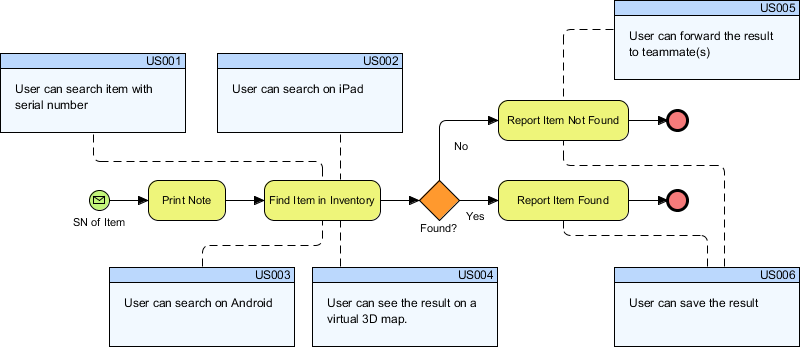The Synergy of BPMN and User Stories: Streamlining Requirements Management with Visual Paradigm
Introduction
In the ever-evolving landscape of software development, effective requirements management is paramount to the success of any project. Bridging the gap between business processes and software development is a challenge that has long plagued project teams. However, a powerful combination of Business Process Model and Notation (BPMN) and User Stories offers a solution that not only enhances clarity and communication but also boosts the overall efficiency of the development process. In this article, we explore the benefits of mapping User Stories with BPMN processes, guiding you through the process and highlighting the advantages it brings to your software development endeavors.

Mapping user stories with a BPMN process can offer several benefits in the context of requirements management and communication with stakeholders. Here are some of the key advantages:
- Clarity in Requirements: BPMN diagrams provide a clear and structured representation of business processes. By mapping user stories to BPMN diagrams, you can ensure that every aspect of the business process is covered in the form of user stories. This clarity helps in capturing all the requirements effectively.
- Visualization: BPMN provides a visual representation of business processes, making it easier for stakeholders, including non-technical ones, to understand how the system will work. User stories linked to BPMN elements offer a tangible connection between the process and the software requirements.
- Traceability: Mapping user stories to specific BPMN elements creates a traceable link between high-level business processes and detailed system requirements. This traceability ensures that every user story is directly related to a specific process step, making it easier to track progress and changes.
- Prioritization: When user stories are linked to BPMN processes, it becomes easier to prioritize them based on the criticality of the corresponding process steps. This helps in focusing development efforts on the most important aspects of the system.
- Communication: BPMN diagrams are a common language used by business analysts and stakeholders to discuss and understand business processes. By incorporating user stories into these diagrams, you facilitate effective communication between business and development teams, reducing the chances of misunderstandings.
- Visibility Control: Creating a separate layer for user stories allows you to control their visibility in BPMN diagrams. This can be particularly useful during discussions with stakeholders who may not want to see user stories but are more interested in understanding the overall process flow.
- Documentation: The mapping of user stories to BPMN processes provides a form of documentation that shows how the system will support each step of the business process. This documentation can serve as a reference for development and testing teams.
- Change Management: When changes are required in the system, having user stories mapped to BPMN processes makes it easier to assess the impact of those changes. You can quickly identify which parts of the process need modification and update the corresponding user stories accordingly.
To map BPMN with user stories, you can follow the steps outlined in the provided text, which involves creating a separate layer for user stories in your BPMN diagram and connecting each user story to the relevant BPMN elements using connectors.
In summary, mapping user stories with BPMN processes enhances the requirements management process, improves communication with stakeholders, and ensures that software development aligns closely with the underlying business processes, leading to more successful and efficient project outcomes.
Summary
The synergy between BPMN and User Stories provides a structured approach to requirements management. It offers clarity in requirements, visualization of business processes, traceability, and improved communication between stakeholders. By mapping User Stories to BPMN elements, you gain better control over prioritization and change management while also simplifying documentation. Moreover, the ability to control the visibility of User Stories in BPMN diagrams ensures that discussions with different stakeholders can be tailored to their specific interests, making the entire process more efficient and effective. This integration not only facilitates a smoother transition from business processes to software development but also contributes significantly to project success.

